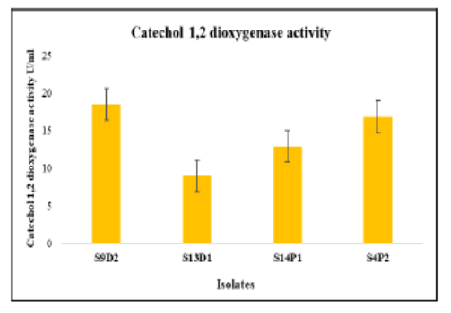


Indian Journal of Science and Technology
Year: 2024, Volume: 17, Issue: 23, Pages: 2412-2420
Original Article
Rupali D Nanekar1, Seema S Kokitkar1∗
1Department of Biotechnology, Changu Kana Thakur Arts, Commerce and Science College, New Panvel (Autonomous), Affiliated to University of Mumbai, Maharashtra, India
*Corresponding Author
Email: [email protected]
Received Date:12 April 2024, Accepted Date:18 May 2024, Published Date:03 June 2024
Objectives: The main objective of this study was to evaluate the activity of enzymes with hydrocarbon-degrading potential. Methods: Four petroleum hydrocarbon-degrading bacterial strains, S4P2, S14P1, S9D2, and S13D1, were isolated and used to screen the activity of catalase, lipases, and catechol 1, 2-dioxygenase. All the strains were characterized biochemically. The presence of catalase was studied using nutrient agar and absorbance was measured at 240 nm due to the disappearance of peroxide. Qualitatively, the presence of lipase was studied on tributyrin agar (TBA) plates. The lipase activity was quantified using the titrimetric method. The activity of catechol 1, 2-dioxygenase (C12O) was screened by the formation of the product cis, cis-muconic acid (CCMA) by measuring the absorbance at 260 nm. Findings: Bacterial strains S4P2, S14P1, S9D2, and S13D1 showed clear halo zones around TBA plates, indicating lipase activity. Similarly, quantitively lipase activity was highest in S4P2 (0.034±0.01 U/ml) and S13D1 (0.027±0.01 U/ml) followed by S9D2 (0.024±0.01 U/ml) and S14P1 (0.024±0.01 U/ml) respectively. The presence of catalase was confirmed by effervescence after the addition of H2O2 on cultured nutrient agar, quantitative screening was performed by checking the decrease in absorbance at 240 nm. The maximum activity was observed in isolates S9D2 and S14P1. The total catechol 1, 2-dioxygenase activity was found to be 18.48±0 U/ml and 8.96±0.56 U/ml in S9D2 and S13D1. In contrast, S14P1 and S4P2 showed 12.88±0.56 U/ml and 16. 8±0.U/ml. Novelty: Microbial enzymes play an important role in the degradation of hydrocarbons. The direct application of microbes offers many constraints, so the use of these enzymes as a cocktail may be a solution for bioremediation. In the present study, we aimed to elucidate the enzymes responsible for hydrocarbon degradation in previously unreported strains, Pseudomonas donghuensis and Azospirillum zeae. Therefore, this enzyme can be used as a bioremediation agent for petroleum-contaminated sites.
Keywords: Petroleum; Catalase; Lipases; Catechol 1,2-dioxygenase; Hydrocarbons
© 2024 Nanekar & Kokitkar. This is an open-access article distributed under the terms of the Creative Commons Attribution License, which permits unrestricted use, distribution, and reproduction in any medium, provided the original author and source are credited. Published By Indian Society for Education and Environment (iSee)
Subscribe now for latest articles and news.